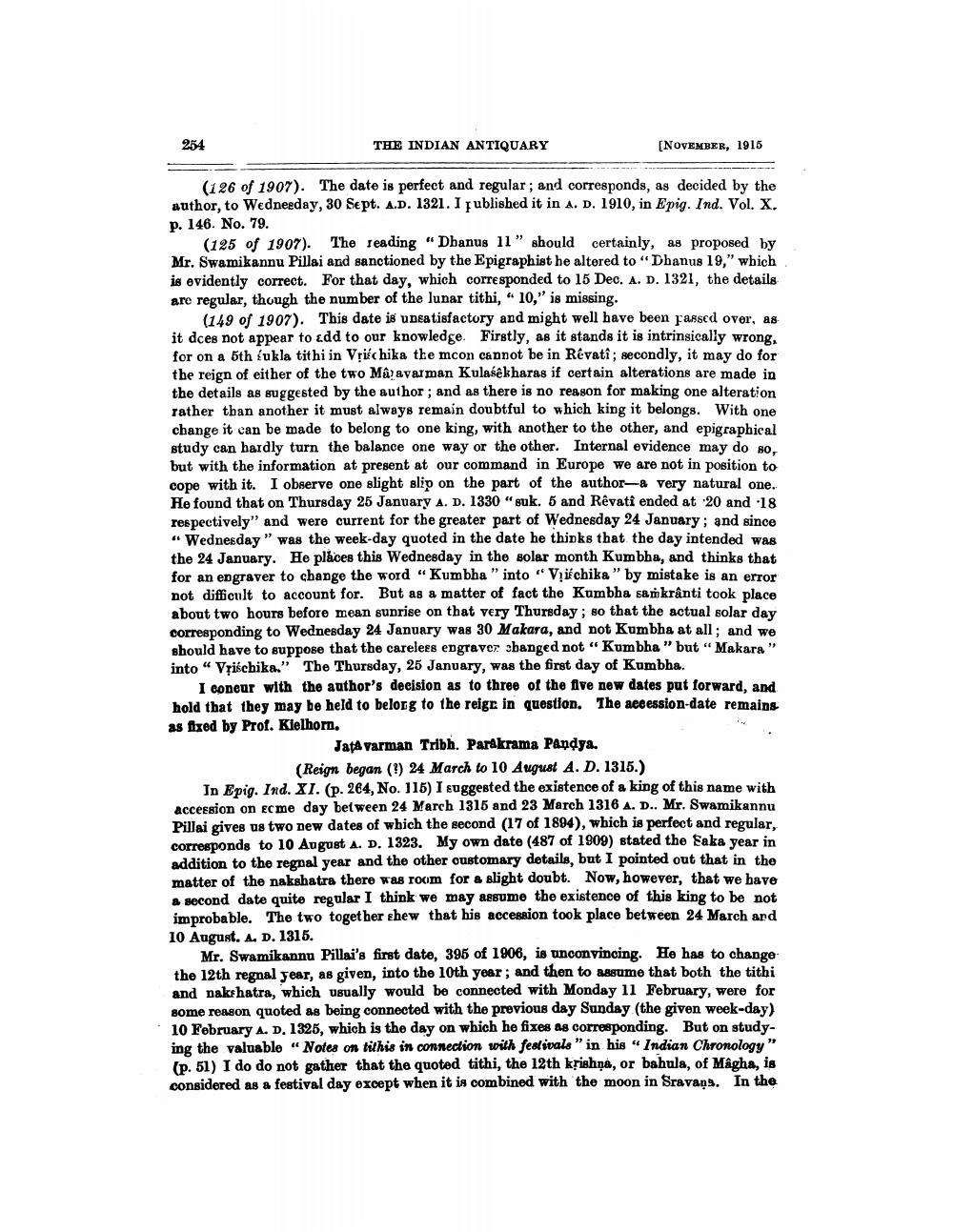________________
254
THE INDIAN ANTIQUARY
[NOVEMBER, 1915
(126 of 1907). The date is perfect and regular; and corresponds, as decided by the author, to Wednesday, 30 Sept. A.D. 1321. I published it in a. D. 1910, in Epig. Ind. Vol. X. p. 146. No. 79.
(125 of 1907). The reading "Dhanus 11" should certainly, as proposed by Mr. Swamikannu Pillai and sanctioned by the Epigraphist he altered to "Dhanus 19," which is evidently correct. For that day, which corresponded to 15 Dec. A. D. 1321, the details are regular, though the number of the lunar tithi, " 10," is missing.
(149 of 1907). This date is unsatisfactory and might well have been passed over, as it does not appear to add to our knowledge. Firstly, as it stands it is intrinsically wrong, for on a 5th (ukla tithi in Vrischika the mcon cannot be in Rêvatî; secondly, it may do for the reign of either of the two Majavarman Kulasekharas if certain alterations are made in the details as suggested by the author; and as there is no reason for making one alteration rather than another it must always remain doubtful to which king it belongs. With one change it can be made to belong to one king, with another to the other, and epigraphical study can hardly turn the balance one way or the other. Internal evidence may do so, but with the information at present at our command in Europe we are not in position to cope with it. I observe one slight slip on the part of the author-a very natural one. He found that on Thursday 25 January A. D. 1330 "suk. 5 and Rêvatî ended at 20 and '18 respectively" and were current for the greater part of Wednesday 24 January; and since "Wednesday" was the week-day quoted in the date he thinks that the day intended was the 24 January. He places this Wednesday in the solar month Kumbha, and thinks that for an engraver to change the word "Kumbha " into "Viifchika" by mistake is an error not difficult to account for. But as a matter of fact the Kumbha samkrânti took place about two hours before mean sunrise on that very Thursday; so that the actual solar day corresponding to Wednesday 24 January was 30 Makara, and not Kumbha at all; and we should have to suppose that the careless engraver changed not "Kumbha " but "Makara" into "Vrischika." The Thursday, 25 January, was the first day of Kumbha.
I coneur with the author's decision as to three of the five new dates put forward, and hold that they may be held to belong to the reign in question. The accession-date remains as fixed by Prof. Kielhorn.
Jata varman Tribh. Parakrama Pandya.
(Reign began (?) 24 March to 10 August A. D. 1315.)
In Epig. Ind. XI. (p. 264, No. 115) I suggested the existence of a king of this name with accession on ɛcme day between 24 March 1315 and 23 March 1316 A. D.. Mr. Swamikannu Pillai gives us two new dates of which the second (17 of 1894), which is perfect and regular, corresponds to 10 August A. D. 1323. My own date (487 of 1909) stated the Saka year in addition to the regnal year and the other customary details, but I pointed out that in the matter of the nakshatra there was room for a slight doubt. Now, however, that we have a second date quite regular I think we may assume the existence of this king to be not improbable. The two together shew that his accession took place between 24 March and 10 August. A. D. 1315.
Mr. Swamikannu Pillai's first date, 395 of 1906, is unconvincing. He has to change the 12th regnal year, as given, into the 10th year; and then to assume that both the tithi and nakshatra, which usually would be connected with Monday 11 February, were for some reason quoted as being connected with the previous day Sunday (the given week-day) 10 February A. D. 1325, which is the day on which he fixes as corresponding. But on studying the valuable "Notes on tithis in connection with festivals " in his "Indian Chronology" (p. 51) I do do not gather that the quoted tithi, the 12th krishna, or bahula, of Mâgha, is considered as a festival day except when it is combined with the moon in Sravans. In the




